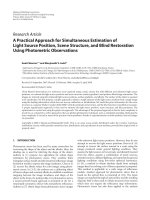Organic Process Research & Development Volume 10 issue 3 2006 [doi 10.1021%2Fop050247m] -- Industrial Catalysis-В A Practical Approach, 2nd edition By J. Hagen. 2006. Wiley-VCH-В Weinheim. Price ВЈ115. 5
Bạn đang xem bản rút gọn của tài liệu. Xem và tải ngay bản đầy đủ của tài liệu tại đây (15.7 KB, 2 trang )
Organic Process Research & Development 2006, 10, 683−684
Developing Processes for
Crystallization-Induced Asymmetric
Transformation
N. G. Anderson*
(Org. Process Res. Dev. 2005, 9, 800−813).
The development of one of the CIAT processes (pp 807808, Scheme 15) was incorrectly ascribed to Tanabe researchers. This work was carried out at Kaneka Corporation,
Japan.
OP068005P
10.1021/op068005p
Published on Web 05/21/2006
Book ReViews *
Organic Reactions, Volume 66. By L. E. Overman.
Wiley: Hoboken, New Jersey. 2005. £71.50. 653 pp. ISBN
0-471-68258-6.
The series, Organic Reactions, continues to provide
outstanding, comprehensive reviews of key reactions in
organic synthesis. The latest volume has only two chapters.
The first, a review of the allylic trihaloacetimidate rearrangement, sometimes called the Overman rearrangement,
is reviewed by Larry Overman and Nancy Carpenter
(University of Minnesota). In an easy-to-read style, the
authors show what a useful reaction this is for converting
allylic alcohols to rearranged acylated allylic amines and how
the products can be further converted. Mechanistic rationales
for the high selectivity, typical of 3,3-sigmatropic rearrangements, are presented. As usual, experimental details and a
comprehensive tabular survey with over 200 references
complete the review (107 pages).
The second, longer chapter, by Marc Noe, Michael Letaric,
and Sheri Snow from Pfizer, with Stuart McCombie, covers
asymmetric dihydroxylation of alkenes (516 pp). This is an
excellent review of the topic, illustrating the scope of the
reaction and experimental procedures. Since the usual
oxidant, osmium tetroxide, is both volatile (bp 130°) and a
low-melting solid (mp 40 °C), as well as being highly toxic,
more detailed safety and environmental procedures could
have been given. Some discussion on the use of the reaction
on large scale would have been useful, particularly in relation
to recovery and reuse of osmium.
Other, easier-to-handle sources of osmium are discussed,
however, as well as secondary oxidants to minimise osmium
use. I would have liked more detailed discussion of solvent
effects on enantioselectivity in a separate section with tables
of resultssalthough the topic is mentioned several times,
this is spread over several sections and is not so coordinated.
*Unsigned
book reviews are by the Editor.
The experimental procedures include preparation of various ligands, immobilised ligands, and methods for immobilising osmium tetroxide on ABS polymer, as well as the
use of such reagents/catalysts/ligands in synthesis. One
kilogram-scale procedure (from the Organic Process Research & DeVelopment paper) is included.
The 400 pages of tables is testimony to the widespread
use of this reaction since its discovery 25 years ago, with
the catalytic version less than 20 years old.
Whereas chapter 1 contains a section on comparison with
other methods, chapter 2 does notsthis would have made
an interesting discussion. Asymmetric epoxidation followed
by ring opening or hydrolytic kinetic resolution of epoxides
has been one large-scale process for converting alkenes to
diols, presumably to avoid toxic osmium and expensive
ligands.
Despite these criticisms, this chapter is an extremely
valuable source of references, and the authors have done an
excellent job in summarising the vast literature (764 references).
In conclusion, Organic Reactions continues to maintain
the high standard of previous volumes, and the latest volume
should be in every organic chemistry library, both academic
and industrial.
OP050246U
10.1021/op050246u
Industrial Catalysis: A Practical Approach, 2nd
edition. By J. Hagen. 2006. Wiley-VCH: Weinheim. Price
£115. 507 + xviii pp. ISBN 3-527-31144-0
The second edition of Professor Hagen’s book on industrial
catalysis has considerably wider scope than the earlier
edition, which was focused very much on heterogeneous
Vol. 10, No. 3, 2006 / Organic Process Research & Development
•
683
Organic Process Research & Development 2006, 10, 684
catalysis. This is what he understands, and this is what he
does best. The second edition is still predominately about
heterogeneous catalysis with chapters on Fundamentals (122
pages); Catalyst Shapes and Production of Catalysts (15 pp);
Shape Selective Catalysts: Zeolites (20 pp); Planning,
Development and Testing of Catalysts (64 pp); Catalysis
Reactors (20 pp); and Heterogeneously Catalysed Processes
in Industry (32 pp).
The latter chapter is heavily focused on bulk and the largervolume fine chemicals and on continuous processes such as
oxidation, reduction, carbonylation, and polymerisation. The
section on planning, etc. has some examples on the use of
statistical methods in catalyst screening and in optimisation
which process chemists may not have seen before. These
chapters are well-written and are a valuable guide for process
chemists into how heterogeneous catalysis is carried out in
industry on large scale.
The earlier chapters on Homogeneous Catalysis with
Transition Metals (44 pp) followed by Homogeneously
Catalysed Industrial Processes (22 pp) seem to merely skim
the surface of these very important topics, and the industrial
applications were not discussed in detail.
Chapters on Biocatalysis, Electrocatalysis, Photocatalysis,
Phase-Transfer Catalysis, and Environmental Catalysis and
Green Chemistry provided a brief introduction to each subject
but without getting into real depth. Given the limitations of
space, this is not surprising. However, these chapters did
not add much to the subject, and I felt many could have
been omitted.
684
•
Vol. 10, No. 3, 2006 / Organic Process Research & Development
Since the text is based on the author’s lecture course for
chemical engineers at the University of Applied Sciences in
Mannheim, Germany, each chapter contains some exercises,
with the answers being provided in a separate “chapter”. Two
extra chapters not previously mentioned are about the
economic importance of catalysis and future developments
of catalysis.
References are listed at the end of the book rather than at
the end of each chapter. These were incomplete and not
particularly up-to-date. The latest reference in Chapter 2
(homogeneous catalysis) is 1988, and in the following
chapter, 2001. Blaser’s important book on Asymmetric
Catalysis on Industrial Scale, Augustine’s books on heterogeneous catalysis, and several recent books on biocatalysis
are surprisingly not mentioned in the references.
In conclusion, the approach towards catalysis in this text
is a little dated, is focused towards the bulk chemical
industry, and will not endear the important topic of catalysis
to the modern process chemist and chemical engineer. Some
of the photographs in the text, which showed scientists/
engineers working in high-pressure catalysis laboratories but
not wearing safety spectacles, also indicate outdated attitudes
to safety.
The book is only recommended to those who wish to gain
an appreciation of heterogeneous catalysis and its application
in the bulk chemical industry.
OP050247M
10.1021/op050247m









